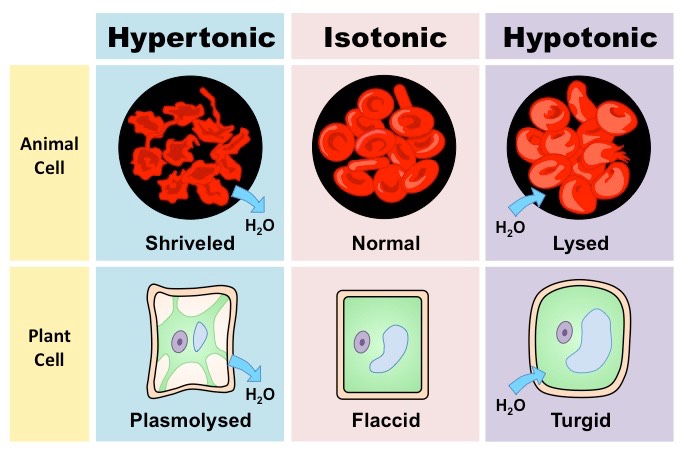![]()
Skill:
• Estimation of osmolarity in tissues by bathing samples in hypotonic and hypertonic solutions
Osmolarity is a measure of solute concentration, as defined by the number of osmoles of a solute per litre of solution (osmol/L)
Solutions may be loosely categorised as hypertonic, hypotonic or isotonic according to their relative osmolarity
- Solutions with a relatively higher osmolarity are categorised as hypertonic (high solute concentration ⇒ gains water)
- Solutions with a relatively lower osmolarity are categorised as hypotonic (low solute concentration ⇒ loses water)
- Solutions that have the same osmolarity are categorised as isotonic (same solute concentration ⇒ no net water flow)
Osmotic Movement between Solutions: Hypertonic (left) and Hypotonic (right)
Estimating Osmolarity
The osmolarity of a tissue may be interpolated by bathing the sample in solutions with known osmolarities
- The tissue will lose water when placed in hypertonic solutions and gain water when placed in hypotonic solutions
- Water loss or gain may be determined by weighing the sample before and after bathing in solution
- Tissue osmolarity may be inferred by identifying the concentration of solution at which there is no weight change (i.e. isotonic)
![]()
Application:
• Tissues or organs to be used in medical procedures must be bathed in a solution with the same osmolarity
as the cytoplasm to prevent osmosis
Tissues or organs to be used in medical procedures must be kept in solution to prevent cellular dessication
This solution must share the same osmolarity as the tissue / organ (i.e. isotonic) in order to prevent osmosis from occurring
Uncontrolled osmosis will have negative effects with regards to cell viability:
- In hypertonic solutions, water will leave the cell causing it to shrivel (crenation)
- In hypotonic solutions, water will enter the cell causing it to swell and potentially burst (lysis)
In plant tissues, the effects of uncontrolled osmosis are moderated by the presence of an inflexible cell wall
- In hypertonic solutions, the cytoplasm will shrink (plasmolysis) but the cell wall will maintain a structured shape
- In hypotonic solutions, the cytoplasm will expand but be unable to rupture within the constraints of the cell wall (turgor)
Summary of the Effects of Solute Concentrations on Cells

